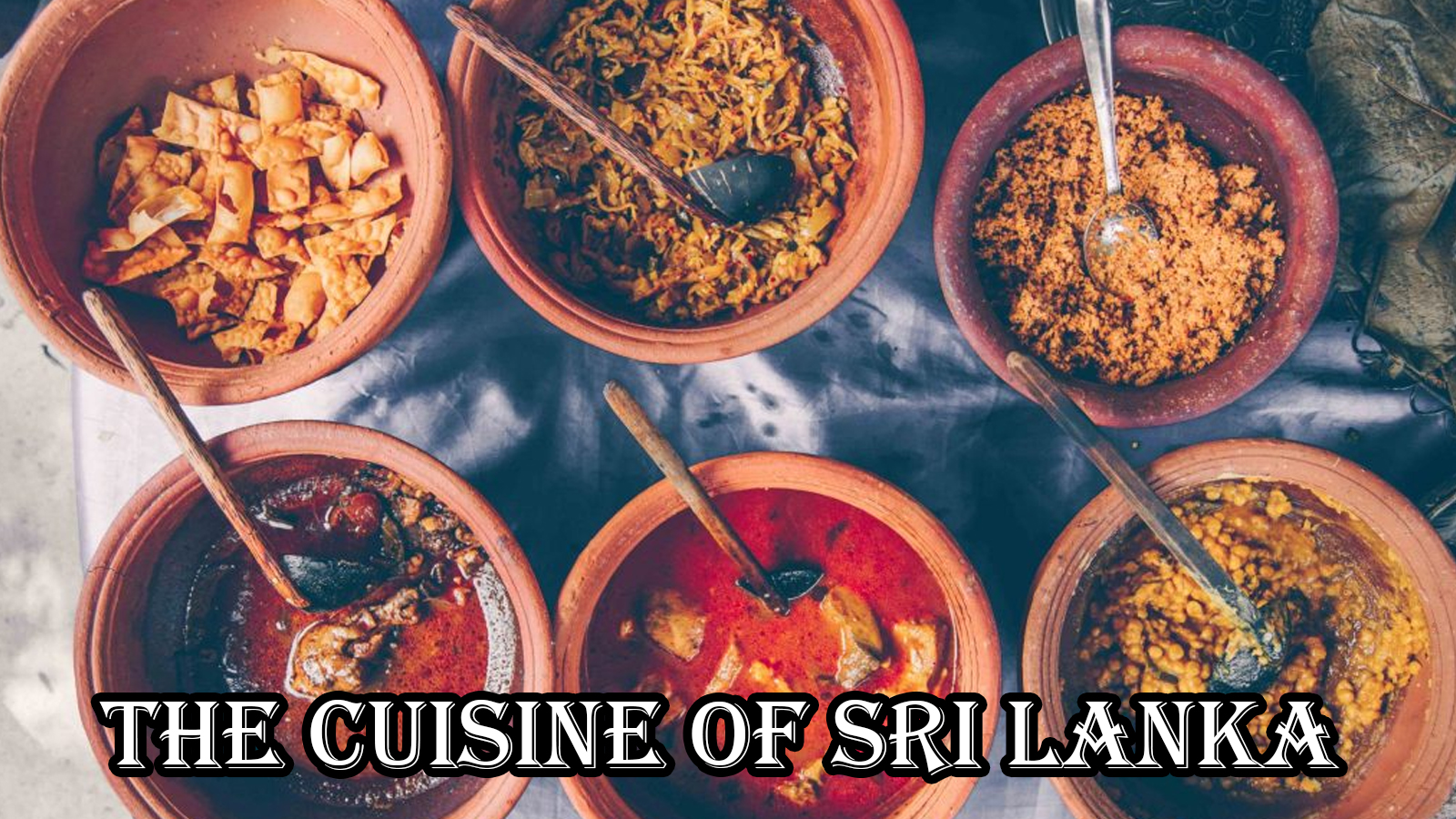Sri Lanka boasts of unique cuisine, shaped by the fruits and vegetables to be found in its abundant garden, and by recipes brought to Sri Lanka by traders and invaders. The Indians, Arabs, Malays, Portuguese, Dutch and English have all left a mark on the Sri Lankan diet.
Curries in Sri Lanka can be very hot indeed although adjustments are often made to suit sensitive western palates. If you find yourself to have taken a mouthful of something that is simply too hot, a gulp of water does not bring you relief. Instead, that’s like throwing fuel on a fire. Far better is a forkful of rice, or better yet some cooling yogurt or curd or even a cucumber. Another surprisingly effective strategy is to sprinkle plain grated coconut over the curry- that’s what those side dishes are for. On the other hand, if the curry is not hot enough the solution to that is to simply have some pol sambol which is a red-hot side dish made with grated coconut, chili and spices.
Sri Lankan rice and curry usually include a variety of small curry dishes either vegetables, meat or fish. Chicken, fish or dried fish are very much popular whereas beef and mutton are also available.
Vegetarians would not have trouble finding tasty food as some unique Sri Lankan vegetable curries are banana (ash plantains), banana flower, breadfruit, jackfruit, mangoes, potatoes, beans, and pumpkins. An accompaniment of mallung (shredded green leaves with spices, lightly fried) is common, and the meal would not be complete without parippu (red lentil dhal) or another pulse curry.
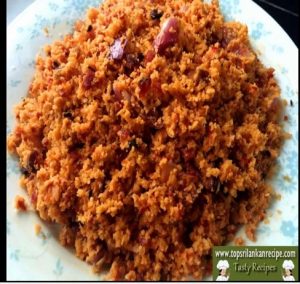
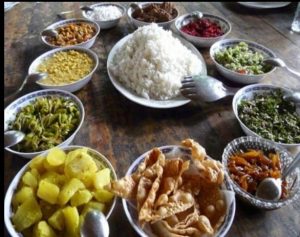
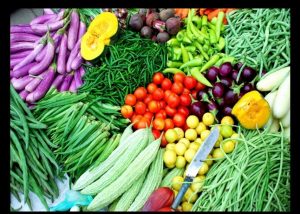
The usual Indian curry varieties are also available in the Sri Lankan cuisine, including the South Indian vegetarian thali and the delicate North Indian biriyani. Also from the northern Jaffna region comes odiyal kool, a seafood stew that is rich in flavor.
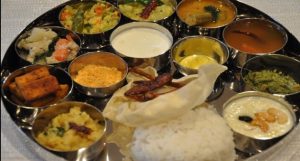
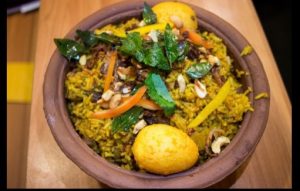
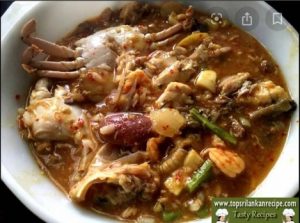
The spices used to bring out the flavors of Sri Lankan curries are all made locally. Spices, particularly cinnamon are the reason why Europeans were interested in Sri Lanka. The essential ingredients in most curries are chili powder, fresh chilies, turmeric, cinnamon quills, curry powder, curry leaves, pandanus leaves, garlic, coconut milk and sometimes crushed maldive fish.
Disappointingly, and despite the huge amount of rice eaten in Sri Lanka, it is often bland. It generally has a musty smell and tastes just like cardboard. Try the delicious partly hulled red rice instead!
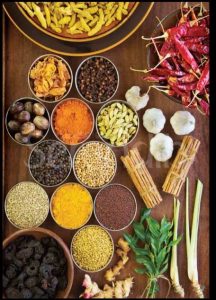
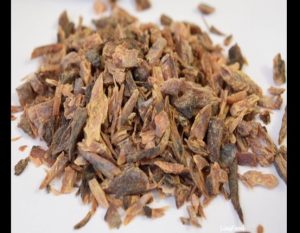
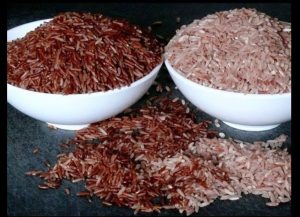
Coastal towns of Sri Lanka provide the whole country with fresh fish. Prawns are also widespread. And in Hikkaduwa, Unawatuna and Tangalle you can find delicious crab and lobster. A popular dish in the south of the island is ambul thiyal, a pickle usually made from tuna, which is translated as ‘sour fish curry’.
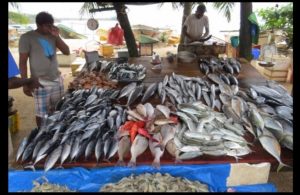
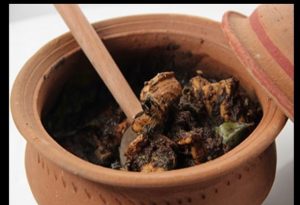
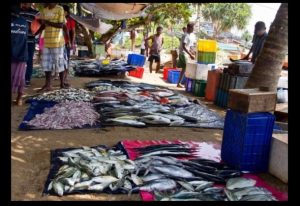
Other unique Sri Lankan dishes are hoppers and string hoppers. Hoppers are usually eaten for breakfast or as an evening snack. A regular hopper is rather like a small bowl-shaped pancake, skillfully fried over a high flame and sometimes served with an egg fried into the middle or with honey and yogurt. String hoppers are tangled little circles of steamed noodles used as a curry dip instead of rice. They make a filling meal at breakfast or dinner.
Also a very popular breakfast dish among Sri Lankans is fresh bread dipped in a curry with thin gravy called hodhi usually dhal curry.
Another rice substitute that can be found is pittu, a mixture of flour and grated coconut steamed in a bamboo mold so that it comes out shaped like a cylinder.
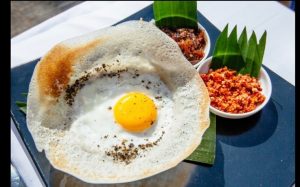
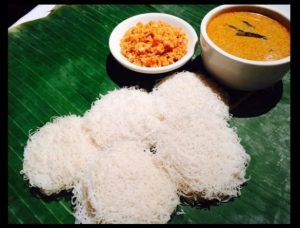
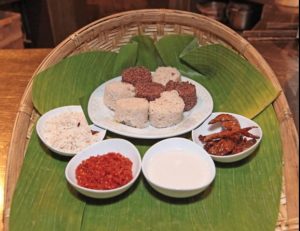
Lamprais, a popular dish of Dutch origin, is made of rice that’s boiled in meat stock then added to vegetables and meat and slowly baked in a banana-leaf wrapping. It is much more appetizing than the literal translation ‘lump rice’ suggests.
At teatime you can dine lightly on a plate of short eats. This is the local term for a selection of ‘Chinese’ rolls even though they are not really like Chinese spring rolls. The range of short eats would include meat or vegetable patties, cutlets, pastries and vadai (made with lentils or flour). At these shops a significant amount of short eats are served and the bill is added up according to how many are left.
A filling snack, which you can find mainly in street-side huts, is the rotti, a small parcel of anything you fancy wrapped up in a sort of elasticated, doughy pancake. A rotti chopped up and mixed with vegetables (or meat or egg) is called a kottu rotti. If you eat kottu rotti every day, you’ll soon become attuned to the chop-chop sounds of the kottu rotti maker at the local hotel in the evening.
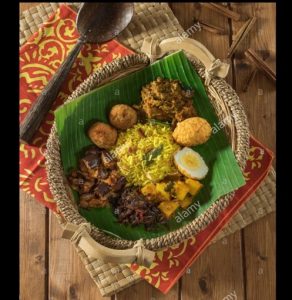
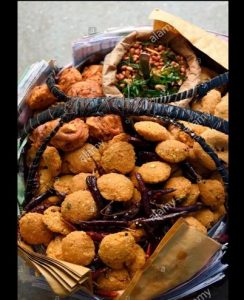
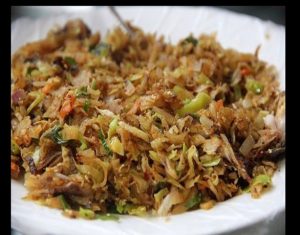
Sri Lanka is well known throughout South Asia for locally originated sweets and desserts. Desserts are usually served as parts of main meals, whereas sweets are consumed at tea times. Unique Sri Lankan desserts include wattalappam which is an egg pudding of Malay origin that’s vaguely caramel-like in taste and curd with honey or curd with treacle. Curd is locally known as kiri-pani and is soothing at any time of the day. Curd is a rich and tasty yogurt made from buffalo milk. It comes in a shallow clay pot with a handy carrying rope which makes it so attractive that you’ll hate to throw it away. The treacle is called kittul and is a syrup extracted from the kitul palm. When boiled and set to form hard blocks you’ll have jaggery, an all-purpose candy, and sweetener.
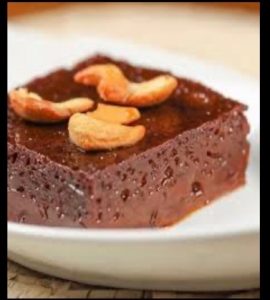
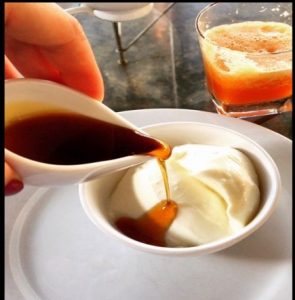
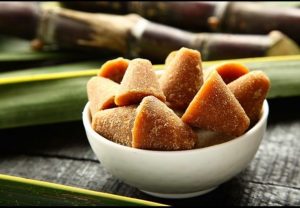
Kiri bath is a dessert of rice, cooked in milk. It’s served at weddings and is traditionally the first solid food fed to babies. It is also enjoyed as a tasty dish with a sambol or jaggery served at special occasions.
Like Indians, Sri Lankans waste no opportunity to indulge in their sweet tooth by sweets known as rasakavili. You could try kavum, a spiced flour and treacle battercake fried in coconut oil or aluva, a rice flour, treacle and cashew-nut fudge. Another Sri Lankan dessert specialty is the dark and delicious kalu dodol made up of coconut milk, jaggery and cashew nuts. These desserts are traditional sweets for the Sinhala and Tamil New Year.
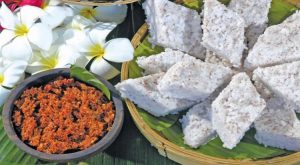

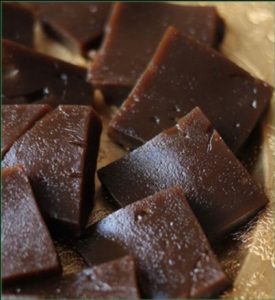
Buddhism and Ayurvedic medicine have contributed to nourish the Sri Lankan cuisine. This is evident from the customs and ethics that prevail in the country. Further, different beliefs, blessings and worships have also contributed to nurturing the country’s food habits. The Sri Lankan traditional cuisine is an exclusive and unparalleled cultural heritage of Sri Lanka.
Rtr. Sandithi Jagoda
ශ්රී ලංකාව අද්විතීය ආහාරපානවලින් සමන්විතය. එයින් බහුල ප්රමාණයක් අප ගෙවතු උයනේ වගා කල හැකි පලතුරු හා එළවළු වලින් සෑදිය හැක. තවද ශ්රී ලංකාවට වෙළඳුන් සහ ආක්රමණිකයන් විසින් වට්ටෝරු ගෙන එන ලදී. ඉන්දියානුවන්, අරාබිවරුන්, මැලේ ජාතිකයින්, පෘතුගීසි, ලන්දේසි සහ ඉංග්රීසි යන සියල්ලන්ම ශ්රී ලාංකික ආහාර වේලෙහි සලකුණක් තබා ඇත.
ශ්රී ලංකාවේ ව්යංජන සැර බවින් අධික වේ. එබැවින් බටහිර තාලයට ගැලපෙන පරිදි වෙනස්කම් සිදු කළ ඇත. අධික සැර යමක් මුඛයට ගත් විට, වතුර පොදක් ඔබට සහනයක් ගෙන දෙන්නේ නැත. එය ගින්නක් මත ඉන්ධන විසි කිරීමක් වැනිය. මෙවැනි අවස්ථාවකදී වඩා හොඳ විසඳුමක් වන්නේ බත් පොදක්, සිසිල් යෝගට් හෝ කිරි කෝප්පයක් , පිපිඤ්ඤා ගෙඩියක් වැනි දෙයකි. තවත් පුදුම හිතෙන උපාය මාර්ගයක් වන්නේ ව්යංජන මත ගාන ලද පොල් ඉසිමය. අනෙක් අතට, ව්යංජනය ප්රමාණවත් තරම් සැර නොවන්නේ නම් එයට විසඳුම වන්නේ ගාන ලද පොල්, මිරිස් සහ කුළුබඩු වලින් සාදන ලද අතුරු කෑමක් වන පොල් සම්බල් ටිකක් සාදාගැනීමයි.
බත් සමග අනුභව කරන සාමාන්ය ව්යංජන එළවළු, මස්, මාළු හෝ වියළි මාළු වේ. කුකුළු මස්, මාළු හෝ වියළි මාළු ඉතා ජනප්රිය වන අතර හරක් මස් සහ එළුමස් ද තිබේ.
අළු කෙසෙල්, කෙසෙල් මල, කොස්, අඹ, අර්තාපල්, බෝංචි සහ වට්ටක්කා වැනි සුවිශේෂී ශ්රී ලාංකික එළවළු ව්යංජන නිසා නිර්මාංශිකයින්ට රසවත් ආහාර සොයා ගැනීමට අපහසු නොවනු ඇත. මැල්ලුම් සහ පරිප්පු නොමැතිව ආහාර වේලක් සම්පූර්ණ නොවේ.
දකුණු ඉන්දියානු නිර්මාංශ තාලි ව්යංජනය සහ උතුරු ඉන්දියානු බුරියානි ඇතුළු සුපුරුදු ඉන්දියානු ව්යංජන ප්රභේද බොහෝමයක් ශ්රී ලාංකික ආහාරවල තිබේ. උතුරේ යාපනය ප්රදේශයේ ඔඩියල් කූල් නම් මාළු ඉස්ටුව රසයෙන් පොහොසත් වේ.
ශ්රී ලාංකික ව්යංජන වල රසය ඉස්මතු කිරීමට භාවිතා කරන කුළුබඩු සියල්ලම දේශීයව සාදා ගනු ඇත. යුරෝපීයයන් ශ්රී ලංකාව කෙරෙහි උනන්දුවක් දැක්වීමට හේතුවද මෙයයි. බොහෝ ව්යංජන වල අත්යවශ්ය අමුද්රව්ය වන්නේ මිරිස් කුඩු, නැවුම් මිරිස්, කහ, කුරුඳු, කරපිංචා, පැන්ඩනස් කොළ, සුදුළූණු, පොල් කිරි සහ විටක තලා දැමූ උම්බලකඩය.
ශ්රී ලංකාවේ විශාල සහල් ප්රමාණයක් අනුභව කළ නමූත්, එයට කාඩ්බෝඩ් රසයක් ඇත. එය වෙනුවට අර්ධ වශයෙන් පොලාගත් රතු සහල් අනුභව කරන්න!
ශ්රී ලංකාවේ වෙරළබඩ නගර මුළු රටටම නැවුම් මසුන් සපයයි. ඉස්සන් ද බහුලව දක්නට ලැබේ. හික්කඩුව, උණවටුන සහ තංගල්ල වැනි ස්ථානවලින්, ඔබට රසවත් කකුළුවන් හා පොකිරිස්සන් සොයා ගත හැක. දිවයිනේ දකුණේ ජනප්රිය ආහාරයක් වන්නේ ටූනා වලින් සාදන ලද අම්බුල් තියාල් ආහාරයයි.
අනෙකුත් සුවිශේෂී ශ්රී ලාංකික කෑම වන්නේ ආප්ප සහ ඉදි ආප්ප ය. ආප්ප සාමාන්යයෙන් උදේ ආහාරය සඳහා හෝ සවස කෑමක් ලෙස අනුභව කරනු ලැබේ. සාමාන්ය ආප්පයක් කුඩා පාත්ර හැඩැති පෑන්කේකයක් වැනි ය. ඉහළ ගින්නක් මත බදින අතර සමහර විට බිත්තරයක් මැදට බදින ලද වේ. එය මී පැණි හෝ යෝගට් සමග අනුභව කරනු ලැබේ. ඉදි ආප්ප යනු බත් ආදේශකයකි. එය තැම්බූ නූඩ්ල්ස් හා සමාන කුඩා රවුම්ක් ය. මෙය උදේ ආහාරයක් හෝ රාත්රී ආහාරයක් ලෙස පිළියෙළ කරනු ලැබේ.
ශ්රී ලාංකියන් අතර ඉතා ජනප්රිය උදෑසන ආහාරයක් වන්නේ නැවුම් පරිප්පු ව්යංජනයක පොඟවා ගත් පාන්ය. තවත් බත් ආදේශකයක් වන්නේ පිට්ටු. එය තැම්බූ පිටි සහ ගාන ලද පොල් මිශ්රණයක් වේ. එය සිලින්ඩරාකාර හැඩයකින් සමන්විත වේ.
සවස් කාලයට ඔබට ‘shorteats’ පිඟානක් ආහාරට ගත හැකිය. ‘Chinese rolls’ යනු භාවිතා වන දේශීය යෙදුමයි. ‘Shorteats’ පිඟානකට පැටිස්, කට්ලට්, පේස්ට්රි සහ වඩේ ඇතුළත් වේ. මෙම සාප්පු වලදී ‘shorteats’ පිඟානක ඉතිරිව ඇති ප්රමාණය අනුව බිල්පත එකතු කරනු ලැබේ.
ඔබට වීදි දෙපැත්තේ පැල්පත්වල සොයා ගත හැකි කෑමක් වන්නේ රොටි ය. ඔබ කැමති ඕනෑම දෙයක් පිටි
සමග ගුලි කර පෑන්කේකයක් ලෙස ඔතා ගත හැක. රොටී, කපාගත් එළවළු (හෝ මස් හෝ බිත්තර) සමඟ මිශ්ර කළ විට කොත්තු රොටි ලෙස හැඳින්වේ. ඔබ සෑම දිනකම කොත්තු අනුභව කරන්නේ නම්, කොත්තු රොටි නිෂ්පාදකයාගේ ‘චොප්-චොප්’ ශබ්දයට ඉක්මනින් හුරු වේ.
රසකැවිලි සහ අතුරුපස සඳහා ශ්රී ලංකාව දකුණු ආසියාව පුරා ප්රසිද්ධය. අතුරුපස සාමාන්යයෙන් ප්රධාන ආහාර වේලෙහි කොටසක් ලෙස පරිභෝජනය කරන අතර තේ වේලාවන්හි රසකැවිලි පරිභෝජනය කරනු ලැබේ. අද්විතීය ශ්රී ලාංකික අතුරුපස අතරට වටලප්පම් ඇතුළත් වන අතර එය මැලේ සම්භවයක් ඇති බිත්තර පුඩිමකි. එය කැරමල් රසයෙන් යුක්ත වේ. මීකිරි ද ඉතාමත් ප්රසිද්ධ අතුරුපසකි. දේශීයව කිරි-පැණි ලෙස හැඳින්වෙන අතර දවසේ ඕනෑම වේලාවක එය අනුභව කළ හැක. මීකිරි යනු මී හරකුන්ගෙන් සාදන ලද රසවත් යෝගට් වර්ගයකි. එය ආකර්ෂණීය නොගැඹුරු මැටි බඳුනක මිලදී ගත හැක. කිතුල් පැණි ලෙස හඳුන්වන්නේ කිතුල් අත්ලෙන් ලබාගත් සිරප් වර්ගයකටය. තම්බා කුට්ටි කළ සූදානම් කළ විට ඔබට හකුරු ලැබේ. කිරි බත් යනු කිරි වලින් පිසින ලද ආහාරයකි. එය මංගල උත්සවවලදී පිරිනමන අතර සාම්ප්රදායිකව ළදරුවන්ට ලබා දෙන පළමු ආහාරයද වේ. විශේෂ අවස්ථා වලදී පිරිනමන ලද කිරි බත් ලුණුමිරිස් හෝ හකුරු සමග භුක්ති විඳිය හැක.
ඉන්දියානුවන් මෙන්, ශ්රී ලාංකිකයන් රසකාවිලි බොහෝමයක් සාදයි. අලුවා යනු පොල්තෙල්වල බඳින ලද පිටි සහ පැණි මිශ්රණයකි. තවත් ශ්රී ලාංකික අතුරුපස විශේෂයක් වන්නේ පොල් කිරි, හකුරු සහ කජු වලින් සාදන ලද රසවත් කළු දොදොල් ය. මේ අතුරුපස සියල්ලම සිංහල හා දෙමළ අලුත් අවුරුද්දේ සාම්ප්රදායික රසකැවිලි වේ.
බුද්ධාගම සහ ආයුර්වේද වෛද්ය විද්යාව ශ්රී ලාංකික ආහාර වට්ටෝරුව වැඩි දියුණු කිරීමට දායක වී තිබේ. රට තුළ පවතින සිරිත් විරිත් හා ආචාර ධර්ම වලින් මෙය පැහැදිලි වේ. තවද, විවිධ විශ්වාසයන්, ආශිර්වාද සහ නමස්කාරයන් රටේ ආහාර පුරුදු වැඩි දියුණු කිරීමට දායක වී ඇත. ශ්රී ලංකාවේ සාම්ප්රදායික ආහාරපාන වට්ටෝරුව සුවිශේෂී හා අසමසම සංස්කෘතික උරුමයකි.
Translated by Rtr. Suwithi Karunasekara
